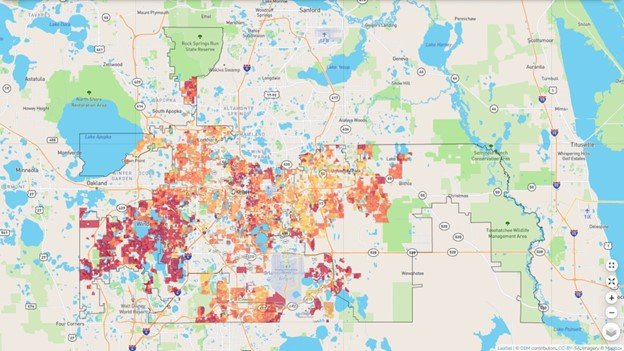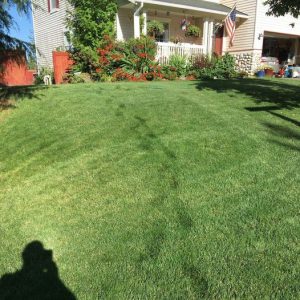It is true that swampy Florida has a dry season, and the landscape is typically thirstiest in April. No April showers here! There is a season to apply more water and calibrate the system, and there is a season to back off the irrigation. If we can calibrate and adjust our irrigation systems, we can reduce water use, reduce nutrient pollution in our water, and reduce the use of pesticides later in the season, which are often related to diseases from overwatering or weeds from not calibrating the system.
Basically, if you do good work in the spring, you can save money and time later in the season without sacrificing quality! In fact, you will likely improve the quality!
Wet and Dry Season
Technically speaking, many folks consider October to be the start of Florida’s dry season. While the rain starts to let up around October, from a landscape perspective, our soils are still moist, and plants are slowing down for the season. On the contrary, in the spring, the land has been drier for months all while the plants are awakening for spring prominence. Often times, spring is when the landscape needs an assist with supplemental irrigation.
Natives & Florida Friendly Plants

Florida native plants are well adapted to these cycles of wet and dry. Go to any semi-swampy area and notice waterlines on cypress trees, not to mention those knees! Cypress knees are pneumatophores that are a fantastic plant adaptation for accessing oxygen by peeking above the waterline like a snorkel in flooded stagnant swamps. Just a few months after floods, water recedes, and you can walk among the knees. Sabal palms are similarly well adapted. While not all plants, even Florida natives, are right for every place, selecting Florida native plants or Florida Friendly plants for the right wet and dry conditions can be a good choice for an attractive landscape without supplemental irrigation.
Realistically, most desirable landscapes in Central Florida rely on supplemental irrigation.
Too little, too much, just right – Irrigation
In general, we use way too much irrigation. Science says HOA requirements are a big reason behind the fear of being that house in the neighborhood. Other science can see who the water abusers are via utility data.

We know the high-water users are using twice as much as what our UF/IFAS best management practices recommend.
Do they have rain shut-off sensors? It is illegal if not.
Is it the homeowner setting the irrigation system? Or a professional?
What about the water utility? How is it that we know the water use data but fail to specifically target the users . . . We know the addresses!!!!!
Either way, there is a time to apply more water, and there is a time to apply less water. By honoring these natural cycles in our manmade landscapes, we can improve water use efficiency and nutrient uptake by plants, rather than running off or leaching nutrients into local bodies of water in the form of pollution.
There could even be a few months in the winter and the summer when you can completely turn off your irrigation system. The holiday season through February the landscape is still sleepy. The summer, when we have predictable afternoon thunderstorms can provide your landscape with plenty of water. It does seem like some zip codes get the storms, while others do not, so blanket recommendations are challenging.

Tips for Watering
Do not water between 10 am and 4 pm. The hottest times in the day are when we lose the most water to evaporation before it gets to the plants.
Set your timers per county restrictions to water one or two days per week. Irrigation times vary based on season. Prepare for the dry season. Calibrate those irrigation systems. If perfect, weed free turf is your goal, calibration is key! Even if perf turf is not your goal, check the system for leaks and breaks, repair, and match the right plants to the right places in the yard.
Water when footprints remain in wilted grass.
| Month | Water Time (in minutes) |
| January | 12 |
| February | 10 |
| March | 17 |
| April | 40 |
| May | 64 |
| June | 50 |
| July | 49 |
| August | 60 |
| September | 48 |
| October | 43 |
| November | 32 |
| December | 16 |
https://livinggreen.ifas.ufl.edu/topics/water/lawn-care-and-irrigation/
Calibrate the system for coverage
From a landscaping perspective, you want to calibrate your irrigation system, which is especially important for keeping turf in the lawn competition. Yeah, water savings. That does not really impact your business, but weeds do!
Areas in the turf or landscape that get too dry due to irrigation issues or poor coverage will cause stressed plants. Stressed plants suffer. Weeds will play where stressed plants lay. You will probably not notice the weeds displacing turf until a few months of weed growth. Now the weeds are established. Now you have to resort to expensive chemical herbicides to correct the issue. While herbicides are effective, they are formulated to kill stuff! Even in a best case scenario, the place in the turf where the dead weeds were becomes a huge brown spot. Another thing that happens, warm season weeds take over, like crabgrass. It blends into the turf for months, outcompeting the desired grass. Then, the cool season comes, and the warm season weed dies, laving a large, brown spot in the turf and unhappy clients.
Calibrate your irrigation systems and prepare for the spring dry season!
For you weather nerds, here is an interesting meteorological report about Central Florida’s wet and dry seasons: https://www.weather.gov/media/mlb/climate/wetdryseason.pdf
More on Watering Your Florida Lawn: https://edis.ifas.ufl.edu/publication/LH025
 1
1
